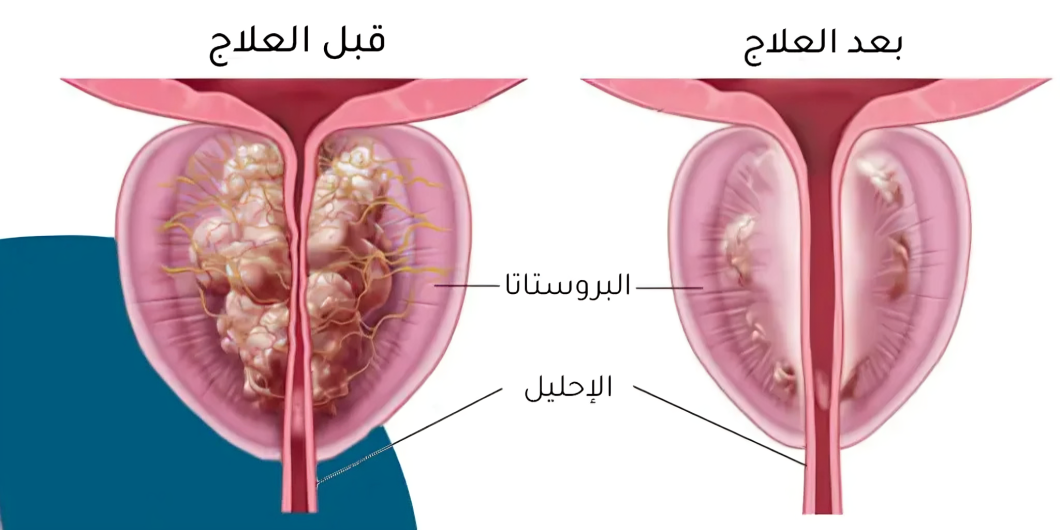
Treatment of enlarged prostate in Türkiye with Victoria Center
Advanced solutions for a more comfortable and confident life
At Svictoria Center in Istanbul, we understand that men’s urinary health is an essential component of their daily quality of life, as well as their sexual and psychological health. Among the most common problems affecting men over the age of 40, benign prostatic hyperplasia (BPH) is one of the most prominent challenges that can directly impact lifestyle.
We provide comprehensive and advanced medical care for the treatment of prostate enlargement, using the latest medical devices and surgical and non-surgical techniques, delivered by a specialized medical team that combines extensive experience with a humane vision.
What is the prostate gland and what is its function?
The prostate gland is a small, walnut-sized organ located just below the bladder and surrounding the urethra, the tube that carries urine from the bladder out of the body. The prostate secretes a fluid that nourishes sperm and helps transport them during ejaculation. With age, this gland may begin to grow abnormally, narrowing the urethra and causing bothersome symptoms.
What is benign prostatic hyperplasia?
Benign prostatic hyperplasia (BPH) is a common condition unrelated to prostate cancer. It occurs when prostate cells begin to multiply abnormally, causing the gland to enlarge. This enlargement can compress the urethra and interfere with normal urine flow.
Although BPH is not a serious condition in itself, it can cause chronic urination problems, negatively impact daily life, and lead to serious complications if left untreated.
What are the symptoms of an enlarged prostate?
Symptoms vary from person to person, but often include:
- • Frequent need to urinate, especially at night (nocturia)
- • Weak or interrupted urine flow
- • Difficulty starting to urinate or continuing to feel the need to urinate even after finishing
- • Feeling that the bladder is not completely emptied
- • Pain during or after urination
- • Urine leakage after urination
- • Sexual problems such as erectile dysfunction or decreased sexual desire in some cases.
Risk factors: Who is most at risk?
- • Men over the age of forty
- • Having a family history of prostate enlargement
- • Chronic diseases such as diabetes and heart disease
- • Sedentary lifestyle and lack of movement
- • Obesity or overweight
- • High blood pressure
- • Poor eating habits (high fat, low fiber, vitamin deficiency)

Complications of prostate enlargement if left untreated:
Failure to treat an enlarged prostate in a timely manner can lead to complications such as:
-
1- Urinary tract infections:
This occurs as a result of the prostate pressing on the urethra, leading to partial and persistent urinary retention. Prolonged retention of urine in the bladder creates a favorable environment for bacterial growth, causing recurrent infections. If these infections recur, surgical intervention may be necessary to reduce the size of the prostate and facilitate urine flow.
-
2- Acute urinary retention:
In some cases, complete obstruction of the urethra leads to a complete inability to urinate, causing severe pain and becoming an emergency that requires immediate intervention through the insertion of a catheter to empty the bladder.
-
3- Formation of stones in the bladder:
Urine residue can lead to mineral deposits and stone formation, causing inflammation, irritation, and sometimes urinary tract obstruction.
-
4- Weak bladder walls:
Over time, the bladder may lose its elasticity due to the increased effort required to expel urine, leading to weak contractions. In some cases, the bladder regains its efficiency after surgery.
-
5- Impact on kidney function:
Chronic urinary retention and recurrent infections can damage the kidneys, affecting their function over time.
When should you see a doctor?
You should see a doctor if you notice difficulty urinating or other symptoms that may indicate an enlarged prostate. Early detection significantly contributes to successful treatment and reduces the risk of complications. In some cases, there may be no symptoms despite the presence of an enlarged prostate.
Tests required to diagnose prostate enlargement:
Diagnosis relies on several tests, most notably a digital rectal examination, which allows the doctor to assess the size and consistency of the prostate. A urine analysis and blood tests may also be performed to measure prostate-specific antigen (PSA) levels, if necessary.
Benign prostatic hyperplasia treatment options:
Treatments vary depending on the size of the tumor, the patient’s health condition, and their age. They range from medication to minimally invasive techniques, and eventually surgery in cases that do not respond to other treatments. The majority of patients ultimately require surgical intervention.
Benign prostatic hyperplasia treatment at our center in Türkiye.
-
1- Transurethral resection of the prostate (TURP):
The surgeon inserts an instrument through the urethra to remove part of the prostate from within. This procedure helps improve urine flow quickly and effectively, and a catheter may be used temporarily after the procedure.
-
2- Transurethral incision of the prostate (TUIP):
A small incision is made in the prostate to widen the urethra. This procedure is suitable for men with mild to moderate enlargement, or those with health conditions that prevent major surgery.
-
3- Transurethral Microwave Therapy (TUMT):
Microwaves are used to deliver heat that destroys the enlarged part of the prostate, helping to shrink it and facilitate urination. It may take some time to notice improvement, and the treatment may be repeated later if necessary.
-
4- Transurethral needle ablation (TUNA):
Fine needles are inserted into the prostate, and radio waves are passed through them to destroy the enlarged tissue causing the blockage.
-
5- Laser treatment:
Lasers are used to break up or remove enlarged prostate tissue. They offer rapid recovery and fewer side effects compared to traditional surgery, and can be used for patients with other health conditions.
Frequently Asked Questions:
-
1~ What tests are needed to diagnose an enlarged prostate?
Diagnosis begins with taking a medical history, followed by a digital rectal examination to assess the size and shape of the prostate. Urine and blood tests, and urine flow velocity measurement, are also performed.
-
2~ Why is the PSA test requested?
Because prostate-specific antigen (PSA) provides an indication of prostate activity and can reveal the possibility of cancer.
-
3~ What is the importance of urine analysis?
It helps rule out urinary tract infections that may cause similar symptoms. If an infection is found, a urine culture is used to identify the bacteria and determine appropriate treatment.
-
4~ What are the most common surgeries to treat an enlarged prostate?
Transurethral resection of the prostate (TURP) is the most common procedure, is performed without an external incision, and significantly improves symptoms.
-
5~ Does surgery affect erection?
It usually has no effect, but in some cases, erectile dysfunction may occur as a result of damage to the nerves surrounding the prostate, especially in traditional surgeries.
